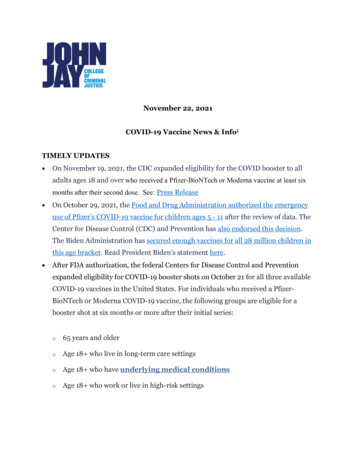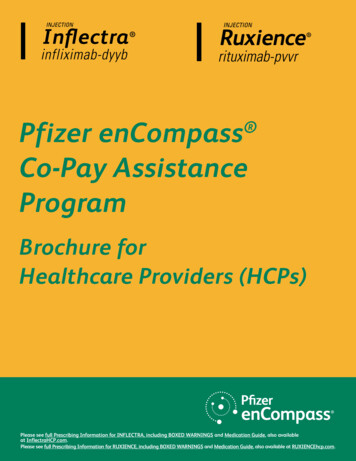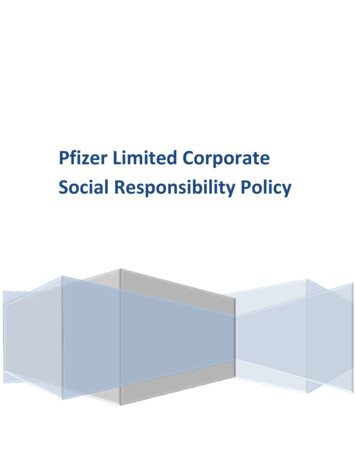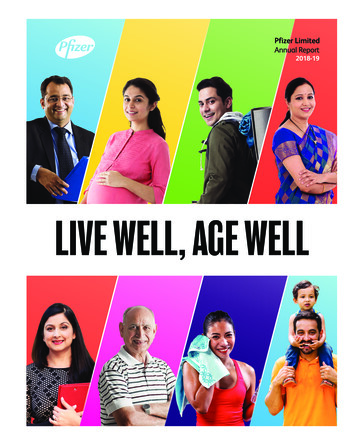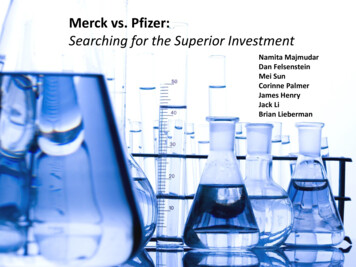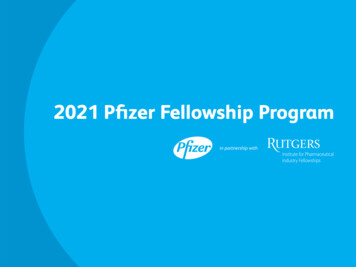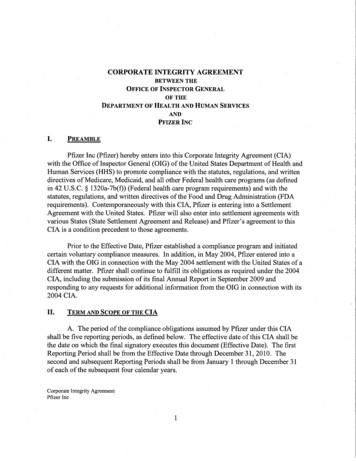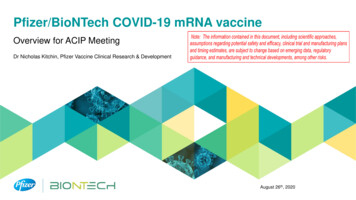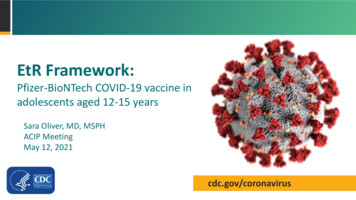
Transcription
EtR Framework:Pfizer-BioNTech COVID-19 vaccine inadolescents aged 12-15 yearsSara Oliver, MD, MSPHACIP MeetingMay 12, 2021cdc.gov/coronavirus
Evidence to Recommendations Framework
Evidence to Recommendations (EtR) Framework Structure to describe information considered in moving fromevidence to ACIP vaccine recommendations Provide transparency around the impact of additional factorson deliberations when considering a recommendation
Evidencvidencee to RRececoommendaendattioionsns (EtR) FrFramameeworkPolicy Question Should vaccination with Pfizer-BioNTech COVID-19 vaccine(2-doses, IM) be recommended for persons 12-15 years of ageunder an Emergency Use Authorization?
Evidence to Recommendations (EtR) FrameworkPICO QuestionPopulationPersons aged 12-15 yearsInterventionComparisonPfizer-BioNTech COVID-19 vaccine (BNT162b2)OutcomesNo VaccineSymptomatic laboratory-confirmed COVID-19Hospitalization due to COVID-19Multisystem inflammatory syndrome in children (MIS-C)SARS-CoV-2 seroconversion to a non-spike proteinAsymptomatic SARS-CoV-2 infectionSerious Adverse EventsReactogenicity grade 3
Evidence to Recommendations (EtR) FrameworkEtR DomainQuestionPublic Health Problem Is the problem of public health importance?Benefits and Harms How substantial are the desirable anticipated effects?How substantial are the undesirable anticipated effects?Do the desirable effects outweigh the undesirable effects? Does the target population feel the desirable effects are large relative tothe undesirable effects?Is there important variability in how patients value the outcome?Acceptability Is the intervention acceptable to key stakeholders?Feasibility Is the intervention feasible to implement?Resource Use Is the intervention a reasonable and efficient allocation of resources?Equity What would be the impact of the intervention on health equity?Values
Evidence to Recommendations (EtR) FrameworkEtR DomainQuestionPublic Health Problem Is the problem of public health importance?Benefits and Harms How substantial are the desirable anticipated effects?How substantial are the undesirable anticipated effects?Do the desirable effects outweigh the undesirable effects? Does the target population feel the desirable effects are large relative tothe undesirable effects?Is there important variability in how patients value the outcome?Acceptability Is the intervention acceptable to key stakeholders?Feasibility Is the intervention feasible to implement?Resource Use Is the intervention a reasonable and efficient allocation of resources?Equity What would be the impact of the intervention on health equity?Values“The intervention” Pfizer-BioNTech COVID-19 vaccine, given to adolescents aged 12–15 years“The problem” COVID-19 among adolescents aged 12–15 years
EtR Domain: Public Health Problem
Public Health ProblemIs COVID-19 disease among adolescents aged 12–15years of public health importance? Are the consequences of COVID-19 serious?Is COVID-19 urgent?Are a large number of adolescents affected by COVID-19?Are there populations disproportionally affected by COVID-19?oNooProbably nooProbably yesoYesoVariesoDon’t know
Public Health Problem:Review of the available evidence COVID-19 incidence and burden estimates COVID-19 associated hospitalization rates COVID-19 associated mortality Multisystem Inflammatory Syndrome in Children (MIS-C) Transmission
Trends in Number of COVID-19 Cases in the USJanuary 22, 2020 – May 3, 2021350000300000250000200000150000100000500000Jan 22 2020Apr 24 2020Jul 26 2020https://covid.cdc.gov/covid -data-tracker/#trends dailytrendscasesOct 27 2020Jan 28 2021May 13 20212021May
Trends in Number of COVID-19 Cases amongAdolescents 12-17 Years of AgeIncident Cases per 100,000 PopulationMarch 1, 2020 – April 30, 2021 1.5 million450400cases amongadolescents 12-17years of age35030025020012 - 15 Years15016 - 17 Years100500Case Earliest Date by Weekhttps://covid.cdc.gov/covid -data-tracker/#demographicsovertime
Proportion of Total COVID-19 Cases by Age Group— United States, March 1, 2020–April 30, 2021100%8%90%% of Total Cases80%18%70%60%50%40%56%30%20%9%9%10%0%0-11 years12-17 years18-49 yearshttps://covid.cdc.gov/covid -data-tracker/#demographicsovertime50-64 years 65 yearsAs more adultsvaccinated, adolescentsaged 12-17 years of agemake up a greaterproportion of total cases:9% of cases reported inApril 2021
Percent of Total Estimated COVID-19 CumulativeIncidence and Total Population by Age Group— United States, February 2020–March 202165 YearsOnce adjusting forunderreporting,50-64 Years22.2 million18-49 YearsSARS-CoV-2 infection inchildren and adolescents5-17 years of age5-17 Years0-4 Years0%20%40%60%% of Total Estimated COVID-19 Cumulative Incidence* cases-updates/burden.htmlU.S. Census Bureau, Population Division, 2020 Demographic Analysis (December 2020 release)80%% of Total Population*100%
Estimated Rates of COVID-19 Disease Outcomesper 100,000 population, by Age Group— United States, February 2020–March 202150,000High rates of infections and symptomatic illness in children 5-17 years of ageProportion of symptomatic patients hospitalized lower among childrenRate Per 100,00040,00030,00020,00010,00000-4 Years5-17 YearsInfections18-49 YearsSymptomatic ases-updates/burden.html50-64 YearsHospitalization 65 Years
Rate Per 100,000 PopulationCumulative Rates of COVID-19-Associated Hospitalizations bySelect Age Groups — COVID-NET, Mar 1, 2020–Mar 27, 20212001501005000-4 yr5-11 yr12-17 data/covid-net/purpose-methods.html18-29 yr
Rate Per 100,000 PopulationCumulative Rates of COVID-19-Associated Hospitalizations bySelect Age Groups — COVID-NET, Mar 1, 2020–Mar 27, 20212001501005000-4 yr5-11 yr12-17 data/covid-net/purpose-methods.html18-29 yr
Three-week Moving Average Rate of Hospitalization bySelect Age Groups —COVID-NET, Dec 27, 2020–April 17, 2021
Cumulative 2009 H1N1 Influenza- and COVID-19-AssociatedHospitalization among Adolescents 12-17 years by MMWR week—FluSurv-NET and COVID-NETRates Per 100,000Population605040302010010 12 14 16 18 20 22 24 26 28 30 32 34 36 38 40 42 44 46 48 50 52 2 4 6 8 10 12 14 16 18MMWR WeekInfluenza2009-2010COVID-19*The 2009-2010, H1N1 pandemic season, includes data from MMWR week 15-39 of the 2008-2009 season
Cumulative Influenza- and COVID-19-Associated HospitalizationsRates among Adolescents 12-17 years by MMWR week—FluSurv-NET and COVID-NETRates Per 100,000Population6050Note: Influenza season begins at MMWR week 40,cumulative rates over a shorter period of time40302010010 12 14 16 18 20 22 24 26 28 30 32 34 36 38 40 42 44 46 48 50 52 2 4 6 8 10 12 14 16 18MMWR Week2009-20102017-20182018-2019Influenza*The 2009-2010, H1N1 pandemic season, includes data from MMWR week 15-39 of the 2008-2009 season2019-2020COVID-19
Hospitalized Children 12–17 Years (n 772)—COVID-NET, Mar 2020–Jan 2021Obesity*AsthmaDevelopmental delayDiabetes mellitus (type 1 or 2)Age (years) ‒ median (IQR)Sex – MaleRace/ethnicityHispanicnon-Hispanic Blacknon-Hispanic Whitenon-Hispanic OtherSevere disease§ 1 underlying conditionImmunosuppressed conditionsBlood disordersNeurologic disordersCardiovascular diseaseChronic lung diseaseFeeding tube dependenceChronic metabolic diseaseOther 20283239471(32)(31)(26)(11)(31)(61)35Percentage of Hospitalized Persons Aged 12–17 Years§Requiringintensive care unit admission or mechanical ventilation*BMI (kg/m2) 95th percentile for age and sex based on CDC growth charts, ICD-10 codes for obesity, or obesity selected on case report form†Includes gastrointestinal or liver disease; renal disease; rheumatologic, autoimmune, inflammatory conditions; abnormality of the airway.COVID-19-associated hospitalizations reported to COVID-NET surveillance system March 1, 2020–January 31, 2020. COVID-NET is a population-based surveillance system that collects data onlaboratory-confirmed COVID-19-associated hospitalizations among children and adults through a network of over 250 acute-care hospitals in 14 states.
Hospitalized Children 12–17 Years (n 772)—COVID-NET, Mar 2020–Jan 2021Obesity*AsthmaDevelopmental delay61% ofDiabetes mellitus (type 1 or 2)Age (years) ‒ median (IQR)Sex – MaleRace/ethnicityHispanicnon-Hispanic Blacknon-Hispanic Whitenon-Hispanic OtherSevere disease§ 1 underlying conditionhospitalizedadolescentswith COVID-19had anunderlyingmedicalconditionImmunosuppressed conditionsBlood disordersNeurologic disordersCardiovascular diseaseChronic lung diseaseFeeding tube dependenceChronic metabolic diseaseOther 20283239471(32)(31)(26)(11)(31)(61)35Percentage of Hospitalized Persons Aged 12–17 Years§Requiringintensive care unit admission or mechanical ventilation*BMI (kg/m2) 95th percentile for age and sex based on CDC growth charts, ICD-10 codes for obesity, or obesity selected on case report form†Includes gastrointestinal or liver disease; renal disease; rheumatologic, autoimmune, inflammatory conditions; abnormality of the airway.COVID-19-associated hospitalizations reported to COVID-NET surveillance system March 1, 2020–January 31, 2020. COVID-NET is a population-based surveillance system that collects data onlaboratory-confirmed COVID-19-associated hospitalizations among children and adults through a network of over 250 acute-care hospitals in 14 states.
Trends in Number of COVID-19 Deaths in the USJanuary 22, 2020 – May 3, 2021450040003500300025002000150010005000Jan 22 2020Apr 24 2020Jul 26 2020https://covid.cdc.gov/covid -data-tracker/#trends dailytrendscasesOct 27 2020Jan 28 2021May3120212021May
COVID-19 Deaths by Age Group, NCHS—January 1, 2020–April 30, 202110090Adolescents 12–17 years:127 COVID-19 deathsCOVID-19 Deaths80701.3% of all deaths amongadolescents6050403020100 11234567891011Age in 14151617181920
Multisystem Inflammatory Syndrome in Children(MIS-C) Severe hyperinflammatory syndrome occurring 2-6 weeks after acute SARS-CoV-2infection, resulting in a wide range of manifestations and complications– 60-70% of patients are admitted to intensive care, 1-2% die1,2 3,742 MIS-C cases have been reported to national surveillance as of May 3, 20213– Median age of 9, with 21% (804) of cases occurred in adolescents 12-17 years– 63% of reported cases have occurred in children who are Hispanic/Latino orBlack, Non-Hispanic– Estimated incidence of 1 to 8.5 MIS-C cases per million person-months1.2.3.Feldstein LR, Tenforde MW, Friedman KG, et al. Characteristics and Outcomes of US Children and Adolescents With Multisystem Inflammatory Syndrome in Children (MISC) Compared With Severe Acute COVID-19. JAMA. 2021;325(11):1074-1087. doi:10.1001/jama.2021.2091Belay ED, Abrams J, Oster ME, et al. Trends in Geographic and Temporal Distribution of US Children With Multisystem Inflammatory Syndrome During the COVID-19Pandemic [published online ahead of print, 2021 Apr 6]. JAMA Pediatr. 2021;e210630. doi:10.1001/jamapediatrics.2021.0630Health Department-Reported Cases of Multisystem Inflammatory Syndrome in Children (MIS-C) in the United States. https://www.cdc.gov/mis-c/cases/index.html
Severity of Multisystem Inflammatory Syndrome inChildren (MIS-C) by AgeICU AdmissionDecreased CardiacFunctionMIS-C Severity2.413-20 yr13-20yr1.76-126-12yryr2.613-20yr13-20 yrReference:MIS-C patients aged0–5 years of age1.96-12yryr6-12012Odds Ratio34Abrams JY, Oster ME, Godfred-Cato SE, et al. Factors linked to severe outcomes in multisystem inflammatory syndrome in children (MIS-C) in the USA: a retrospective surveillance study. LancetChild Adolesc Health. 2021;5(5):323-331. doi:10.1016/S2352-4642(21)00050-X
Adolescents and Transmission of SARS-CoV-2 Some studies observed similar infection rates between children and adults, whileothers found lower infection rates among children compared with adults1,2 Adolescents may be more likely to be infected than younger children ( 10 years)– Supported by contact tracing, test positivity, and population-based seroprevalance data2 Secondary transmission from adolescents can and does occur– While SARS-CoV-2 transmission among students relatively rare, several studies suggesttransmission more likely within high school than elementary school settings3,41.2.3.4.Bi Q et al. Lancet Infect Dis. 2020;20(8):911-919CDC Science Brief: Transmission of SARS-CoV-2 in K-12 schools. science-briefs/transmission k 12 schools.htmlGoldstein E et al. On the Effect of Age on the Transmission of SARS-CoV-2 in Households, Schools, and the Community. J Infect Dis. 2021 Feb 13;223(3):362-369.Larosa E et al. Secondary transmission of COVID-19 in preschool and school settings in northern Italy after their reopening in September 2020. Euro Surveill. 2020;25(49):2001911.
Adolescents and Transmission of SARS-CoV-2 Outbreak investigations have demonstrated efficient transmission among children,adolescents, and young adults, including transmission to older household members1.2.Lopez A et al. MMWR Morb Mortal Wkly Rep 2020;69:1319–1323Schwartz N et al. MMWR Morb Mortal Wkly Rep 2020;69:1457–1459
Adolescents and Transmission of SARS-CoV-2Adults living in a household with a child engaged in full-time in-person school had anincrease in odds of reporting COVID-19 like illness, loss of taste/smell, or positiveSARS-CoV-2 test within previous 14 daysCOVID-19-related outcomescompared to householdswith children not attendingin-person school (reference),prior to adjustment formitigation effortsLessler J et al. Household COVID-19 risk and in-person schooling [published online ahead of print, 2021 Apr 29]. Science. 2021;eabh2939. doi:10.1126/science.abh2939
Public Health Problem:Summary of the available evidenceAdolescents 12–17 years of age are at risk of severe illness from COVID-19 Over 1.5 million reported cases and 13,000 hospitalizations to date– Hospitalization rate higher than 2009-10 H1N1 pandemic Clinical presentation of MIS-C more severe in adolescents than in youngerchildrenCOVID-19 in adolescents may also indirectly impact others' health Adolescents contribute to transmission in households and communities– Including older vulnerable populations Adolescents represent an increasing proportion of recent COVID-19 cases
Public Health ProblemWork Group InterpretationIs COVID-19 disease among adolescents aged 12–15 years ofpublic health importance?oNooProbably nooProbably yesoYesoVariesoDon’t know
EtR Domain: Benefits and Harms
Benefits and HarmsHow substantial are the desirable anticipated effects? How substantial are the anticipated effect for each main outcome forwhich there is a desirable t know
Benefits and HarmsHow substantial are the undesirable anticipated effects? How substantial are the anticipated effect for each main outcome forwhich there is a undesirable t know
Benefits and HarmsDo the desirable effects outweigh the undesirable effects? What is the balance between the desirable effects relative to theundesirable effects?oooooFavors intervention (Pfizer-BioNTech COVID-19 vaccine)Favors comparison (no vaccine)Favors bothFavors neitherUnclear
Benefits and Harms:Summary of the Available Evidence: Benefits The clinical trial for the Pfizer-BioNTech COVID-19 vaccine demonstratedefficacy against symptomatic, laboratory-confirmed COVID-19. The efficacywas 100%High certainty of evidence
Benefits and Harms:Summary of the Available Evidence: Benefits The geometric mean ratio (GMR) for antibodies in 12–15-year-oldscompared with 16–25-year-olds was 1.76 (95% CI:1.47, 2.10), and met thenoninferiority criteria No hospitalizations due to COVID-19 or cases of MIC-C were reported byany trial participants
Benefits and Harms:Summary of the Available Evidence: Harms Serious adverse events (SAE) were reported in a higher proportion ofrecipients of vaccine versus placebo (0.4% vs 0.2%) based on 5 SAEs in thevaccine group and 2 in the placebo groupVery low certainty of evidence Severe reactions were more common in vaccine recipients; a grade 3reaction was reported by 10.7% of vaccinated versus 1.9% of placebo groupHigh certainty of evidence
Benefits and Harms:Summary of the Available Evidence: Harms No deaths were reported among any trial participants Local reactions within 7 days occurred in 91% vaccine recipients– Pain at the injection site most common Systemic reactions within 7 days occurred in 91% vaccine recipients– Fatigue and headache most common Most symptoms resolved in 1-2 days
Benefits and Harms:Summary of the Available Evidence: Harms No cases of anaphylaxis reported in the adolescent (12-15 years of age)study participants No cases of Bell’s Palsy or facial paralysis reported in adolescents Among adolescents 12-15 years of age, 7 (0.6%) in the vaccine group hadlymphadenopathy, compared to 1 (0.1%) participant in the placebo group– Most lymphadenopathy was local (arm or neck region), occurred on the sameside as vaccination, and was reported within 2-10 days
Summary of GRADEOutcome ImportanceDesignFindings (# of studies) Evidencetype Symptomatic lab-confirmedCOVID-19 CriticalRCT (1)Pfizer-BioNTech COVID-19 vaccine is effective in preventingsymptomatic COVID-19 Hospitalization due to COVID-19 ImportantNo studiesData not available from any studiesNDMultisystem inflammatorysyndrome in children (MIS-C)ImportantNo studiesData not available from any studiesNDSARS-CoV-2 seroconversionImportantNo studiesData not available from any studiesNDAsymptomatic SARS-CoV-2infectionImportantNo studiesData not available from any studiesNDSerious adverse events CriticalRCT (1)5 SAEs among vaccinated and 2 among unvaccinated; certainty inthe estimate was very low. No SAEs were judged to be related tovaccination.4 ReactogenicityImportantRCT (1)Severe reactions were more common in vaccinated; any grade 3reaction was reported by 10.7% of vaccinated vs. 1.9% of placebogroup1Benefits1 HarmsEvidence type: 1 high; 2 moderate; 3 low; 4 very low; ND, no data.41
Benefits and HarmsHow substantial are the desirable anticipated effects?- How substantial are the anticipated effect for each main outcome for whichthere is a desirable t know
Benefits and HarmsHow substantial are the undesirable anticipated effects? How substantial are the anticipated effect for each main outcome forwhich there is an undesirable t know
Benefits and HarmsDo the desirable effects outweigh the undesirable effects?- What is the balance between the desirable effects relative to theundesirable effects?oooooFavors intervention (Pfizer-BioNTech COVID-19 vaccine)Favors comparison (no vaccine)Favors bothFavors neitherUnclear
EtR Domain: Values
ValuesCriteria 1:Does the target population feel that the desirable effects arelarge relative to undesirable effects? How does the target population view the balance of desirable versus undesirableeffects? Would patients/caregivers feel that the benefits outweigh the harms and burden? Does the population appreciate and value the Pfizer-BioNTech COVID-19 �t know
ValuesCriteria 2:Is there important uncertainty about, or variability in, how much people valuethe main outcomes? How much do individuals value each outcome in relation to the other outcomes? Is there evidence to support those value judgements? Is there evidence that the variability is large enough to lead to different decisions?oooooImportant uncertainty or variabilityProbably important uncertainty or variabilityProbably not important uncertainty or variabilityNo important uncertainty or variabilityNo known undesirable outcomes
Values:Review of the Available Evidence Review of scientific literature, news media, and reports– Pubmed: (COVID-19 OR coronavirus OR SARS-CoV-2) AND (vaccin* ORimmunization) AND (survey OR questionnaire OR poll) AND (adolescent ORchild* OR parent*)– Google: “COVID-19,” “coronavirus,” “vaccine,” “survey,” “poll,” “hesitancy,”“intent,” “willingness”– Societal Experts Action Network COVID-19 Survey Archive Limited to surveys conducted since authorization of COVID-19 vaccines(December 2020)
Positive COVID-19 Vaccination Intention among Adults††Surveyswith multiple time points are shown with the same color bubble for each time point. Surveys with only one time point are shown in gray.*Positive vaccine intentions includes persons reporting definitely, probably, or somewhat likely to get vaccinated themselves. Some surveys also included persons who already received vaccine.
Values:Surveys of Parents (intent to have children vaccinated) Among parents surveyed, 46-60% plan to get their children vaccinated1-4 Reasons for not vaccinating2:–––––not sure it will be safe (59%)Vaccine developed too quickly (59%)don’t trust info being published about the vaccine (48%)won’t trust right away (44%)don’t have enough info (43%) Parents reported similar or slightly lower intent to vaccinate their childrencompared to intent to vaccinate themselves3,41. Axios/Ipsos April 2-5; Axios/Ipsos April 16-19; Calarco and Anderson preprint; WebMD March 2021.2. National Parents Union Survey January 20213. Simonson M, Baum M, Lazer D, et al. The COVID States Project #45: Vaccine hesitancy and resistance among parents.OSF Preprints, 19 Mar. 2021. https://doi.org/10.31219/osf.io/e95bc4. Parents Together March 2021 Survey
Values:Surveys of Parents (intent to have children vaccinated) Intent to vaccinate children differed by parent's gender, age & income status Fathers were more willing to vaccinate their children than mothers Older mothers were more willing to vaccinate their children than younger mothers Higher income households were more likely to report intent to vaccinate Lower income households twice as likely to say “not sure” about vaccinating theirchildren compared to higher income householdsSimonson preprint; Calarco and Anderson preprint; National Parents Union Survey January 2021; Parents Together March 2021 Survey
Values: Parents' Intent for Children to Receive COVID-19Vaccine Varies by Race/Ethnicity*Positive vaccine intentions includes persons reporting definitely or probably likely to get their child vaccinated.
Values: Surveys of Adolescents and ParentsIntent to get vaccine/have children vaccinatedParents of Adolescents 12-17 years(n 766)Adolescents 13-17 years(n 839)51%definitely/probablywill get vaccinatedCDC/U Iowa Survey of Parents and Adolescents, April 202155%definitely/probablywill get adolescentvaccinated
Values: Surveys of Adolescents and ParentsIntent to get vaccine/have children vaccinated Intent to vaccinate adolescents among the combined sample varied:– Higher for male than female adolescents (57% vs. 50%)– Higher for adolescents whose parents had at least a four-year degree(66%) vs. parents with less education (48%-50%)– Higher in Northeast (64%) and West (60%) vs. Midwest (47%) andSouth (49%) No differences in intent for adolescent COVID-19 vaccination by respondentrace/ethnicityCDC/U Iowa Survey of Parents and Adolescents, April 2021
Values: Surveys of Adolescents and ParentsConcern for COVID-19 or vaccinesLevel: 1 not concerned; 2 slightly concerned; 3 somewhat concerned; 4 very concernedCDC/U Iowa Survey of Parents and Adolescents, April 2021
Values:Summary of the Available Evidence About half of parents say they are likely to get their adolescent vaccinated Intent to vaccinate adolescents differed by parents' gender, race, and income Intent to vaccinate adolescents similar or slightly lower than parental intentto get vaccinated Limited information available on adolescent intent to be vaccinated
ValuesCriteria 1:Does the target population feel that the desirable effects are large relative toundesirable effects? How does the target population view the balance of desirable versus undesirableeffects? Would patients/caregivers feel that the benefits outweigh the harms and burden? Does the population appreciate and value the Pfizer-BioNTech COVID-19 �t know
ValuesCriteria 2:Is there important uncertainty about, or variability in, how much people valuethe main outcomes? How much do individuals value each outcome in relation to the other outcomes? Is there evidence to support those value judgements? Is there evidence that the variability is large enough to lead to different decisions?oooooImportant uncertainty or variabilityProbably important uncertainty or variabilityProbably not important uncertainty or variabilityNo important uncertainty or variabilityNo known undesirable outcomes
EtR Domain: Acceptability
AcceptabilityIs the Pfizer/BioNTech COVID-19 vaccine acceptable to keystakeholders? Are there key stakeholders that would not accept the distribution of benefitsand harms? Are there key stakeholders that would not accept the undesirable effects inthe short term for the desirable effects (benefits) in the future?oNooProbably nooProbably yesoYesoVariesoDon’t know
Acceptability:Jurisdictional approach to administer COVID-19 vaccine April 10th pulse of jurisdictional immunization programs on implementationplanning for adolescentsStrategyDescriptionExample%Share of jurisdictionsMulti-prongedapproach Using a combination of the threebelow approaches, often stagedover time.Region 8 jurisdiction: "Believe a hybridmodel will be needed by utilizing enrolledproviders and other pending outreachactivities."46%Existingprovidernetwork Reaching adolescents throughexisting enrolled providernetwork, including mass vax andpublic health sites.Region 1 jurisdiction: "Plan to encourage inall existing channels including massvaccination clinics, retail pharmacy partners,and some local health dept clinics."28%Pediatricproviders andPCPs Emphasis on reaching populationthrough activation of newpediatric providers and familydoctors.Region 4 jurisdiction: "Actively recruiting foradditional pediatricians to join the COVIDenrollment. Sent out notification to bring onadditional providers."15%School-basedclinics Preparing school-based clinicsand events to reach populationthrough temporary PODs.Region 4 jurisdiction: "Received interestfrom schools with successful teachervaccination clinics will use grant funds tosupport these."11%Source: Jurisdiction data call survey – 05/03/21-05/06/21. n 46.
Acceptability:Provider willingness to administer COVID-19 vaccine October-December 2020 Survey: family physicians, pediatricians, and internalmedicine physicians very willing to administer COVID-19 vaccine in their practices– 97% of providers were willing to administer COVID-19 vaccine– Largest perceived barrier to vaccination was parent/patient concern aboutsafety of COVID-19 vaccineKempe A, et al. Primary Care Physicians’ Willingness and Capacity to Contribute to COVID-19 Vaccine Delivery. Unpublished.
Acceptability: Comfort with adolescent receivingCOVID-19 vaccine at each siteCDC/U Iowa Survey of Parents and Adolescents, April 2021
Acceptability:Summary of the available evidence Most jurisdictions utilizing a variety of implementation strategies tovaccinate adolescents Nearly all primary care providers surveyed are willing to provideCOVID-19 vaccines to their patients Adolescents and their parents report greatest comfort with receivingCOVID-19 vaccine at their primary care providers' offices
AcceptabilityIs Pfizer/BioNTech COVID-19 vaccine acceptable to keystakeholders? Are there key stakeholders that would not accept the distribution of benefitsand harms? Are there key stakeholders that would not accept the undesirable effects inthe short term for the desirable effects (benefits) in the future?oNooProbably nooProbably yesoYesoVariesoDon’t know
EtR Domain: Feasibility
FeasibilityIs the Pfizer/BioNTech COVID-19 vaccine feasible toimplement among adolescents aged 12–15 years? Is the Pfizer-BioNTech COVID-19 vaccine program sustainable? Are there barriers that are likely to limit the feasibility of implementing thePfizer-BioNTech COVID-19 vaccine or require considerations whenimplementing it? Is access to Pfizer-BioNTech COVID-19 vaccine an important concern?oNooProbably nooProbably yesoYesoVariesoDon’t know
Implementation objectives Promote adolescent vaccination as quickly and equitably as possiblethrough a multi-pronged approach Jurisdictions and providers currently vaccinating adolescents 16-17 years Leverage current COVID-19 vaccination infrastructure to adapt over time:– Early summer sprint (May-June)– Increase access (June-July)– Back-to-school campaign (July-September)
Stepwise approach to increasing vaccine access foradolescentsAdolescentvaccinationApply school-focused strategies toensure vaccination opportunitiesStrategically add providers that can reach adolescentsAugment existing infrastructure for vaccinationMayJuneJulyAugust321September
Augment existing public health infrastructure and addnew channels to vaccinate adolescentsCategoryApproachPrimary care providers servingadolescentsPharmacies and HRSAsites1School-based vaccinationUtilize primary care as trusted providers to notify,schedule, and vaccinate their patients, including managingroutine immunizations, particularly as students return toschoolLeverage broad pharmacy footprint and HRSA sites toadminister COVID-19 vaccine to adolescen
May 12, 2021
